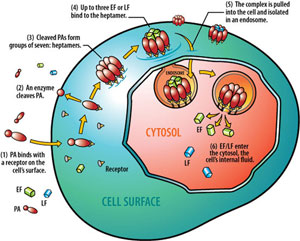About LANL
More About This Science
Using Diversity to Attack the Attacker
Deadly Effects
Multi-pronged fight against anthrax

Quick read
To counter the deadly effects of the anthrax pathogen, multiple approaches are being pursued by Los Alamos, including development of a life-saving antitoxin.
By the time you know you've been infected with anthrax, it's likely too late. The pathogen is a favorite for bioterrorists.
In 2001, seven envelopes containing anthrax spores were sent to news organizations and U.S. senators. Five people died. Thousands of people were given precautionary medical treatment, and dozens of buildings were closed. Terrorists caused a multi-million dollar debt and widespread panic.
Los Alamos National Laboratory has been a key participant in the fight against the causative agent for anthrax (i.e., Bacillus anthracis). To counter the pathogen's deadly effects, multiple approaches are being pursued, including development of an antibody decoy that prevents production of the bacterium's deadly toxin. Other teams are finding vulnerabilities in the bacterium's metabolism.
Additionally, the Laboratory's expertise in DNA sequencing has made it a significant player in DNA forensics. Laboratory researchers are developing new medical treatments, including more effective vaccinations that can act more quickly—vital during a terrorist attack.
The most-prescribed current antibiotics cause side effects and mutated bacteria may be resistant to antibiotics. To defeat something like B. anthracis, you have to look for vulnerabilities.
A Formidable Opponent
Outside a living host, B. anthracis forms spores that are resistant to heat, dehydration and radiation. The spores can either be ingested or enter the body through a break in the skin. Their minuscule size makes inhalation easy.
Anthrax inhalation has a mortality rate of nearly 75 percent if not treated quickly and it's difficult to diagnose because early symptoms mimic a cold or flu.
The spores lodge in the lungs' tiniest air sacs, the alveoli, where they encounter mature white blood cells called macrophages. Macrophages normally envelop and devour invading pathogens. However, the spores resist being eaten and instead germinate into fully active B. anthracis bacteria, which ride along, undamaged, to the lymph nodes; there they burst out to multiply at a staggering rate—and secrete a deadly toxin—in the favorable environment of the bloodstream.

The toxin is a complex set of three proteins working cooperatively to kill cells. The first one, called protective antigen (PA), initiates the attack and binds to a cell receptor, dragging along the other two proteins—edema factor (EF) and lethal factor (LF). Inside the cell, they set off a string of death-dealing events, including the malfunction and swelling of cells and disruption of the intercellular signals that would activate the immune system.
Launching a Decoy
PA is the focus of an antitoxin being developed by a Los Alamos team of Goutam Gupta (project leader), Momchilo Vuyisich, and "Gnana" Gnanakaran. Team members want to block the toxin by keeping PA from attaching to a cell's receptors and preventing mutations from working. The current anthrax vaccine functions similarly, but not as well, and far too slowly.
The decoy has passed several major tests sponsored by the National Institute of Allergy and Infectious Diseases and by the National Institutes of Health's Biodefense Program.
Joining Forces: Metabolism and Mystery Proteins
Other Los Alamos researchers are pursuing the anthrax bacterium down different paths.
A team headed by Christy Ruggiero and Andy Koppisch is trying to develop new antibiotics that specifically target B. anthracis through its metabolism. The idea is to block the bacterium's acquisition of iron (a dietary requirement to function), effectively starving the bacterium.
"As far as we know," says Ruggiero, "Bacillus anthracis is the only pathogen that uses petrobactin."
Currently, the team is studying the effect of turning off several of the bacterium's genes that control petrobactin uptake; then antibiotics that block proteins expressed by these genes will be created.
Koppisch is also leading a separate team that is looking into other metabolic functions and investigating how the bacterium develops resistance to antibiotics, in the hope of preventing resistance before it happens.
Paul Langan's team is attacking one particular enzyme, DHFR, which is essential for the bacterium's survival.
Cliff and Pat Unkefer are working in a new field of study known as "metabolomics" that offers a window into the biochemical workings of an organism, providing new drug targets.
Ryszard Michalczyk's anti-anthrax team is studying six extra genes unexpectedly found on a circular piece of B. anthracis DNA—leading to additional drug targets.
A combination of these Los Alamos strategies may work in tandem for stronger results, leading to a future that is safe from anthrax.

Seismic sounds
Eureka moment arrives with a loud, sharp crack
Paul Johnson finds himself caught up in a mystery—how sound waves from an earthquake can trigger new events at distances far beyond what seemed possible . . .
Currents, the Laboratory's monthly employee magazine, highlighting people in the workplace.








